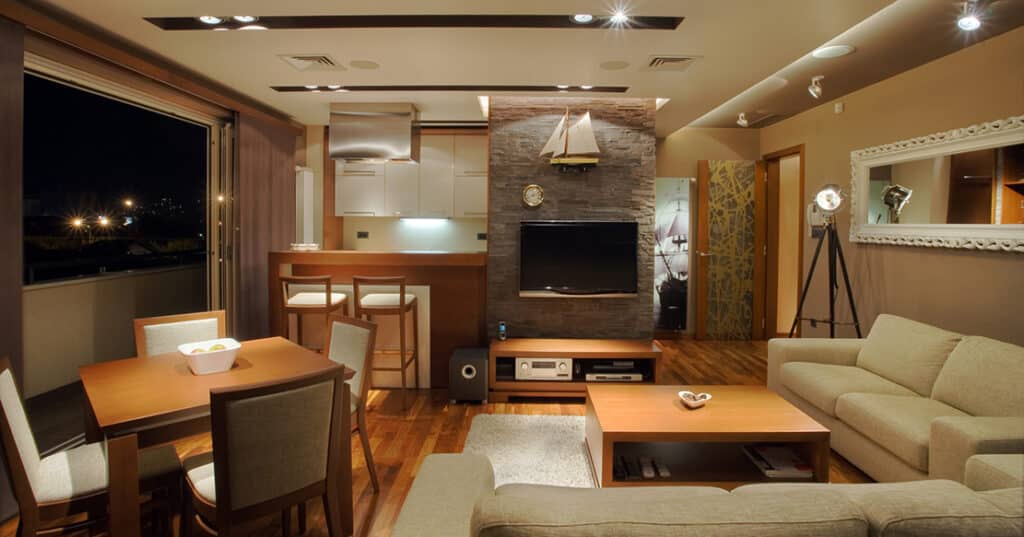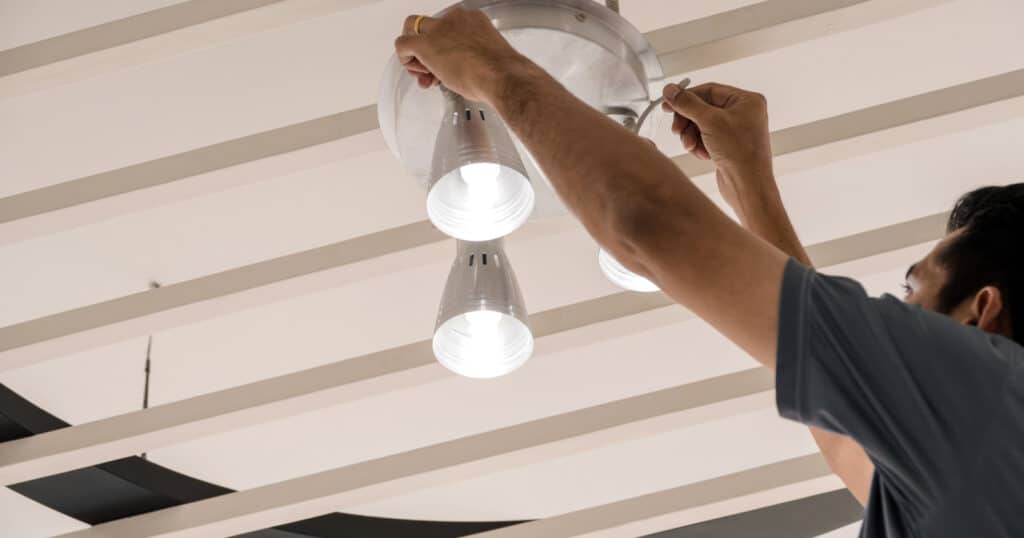What is Architectural Lighting?
Architectural lighting is the art of designing lighting systems. This applies to both indoor and outdoor spaces, using electric or natural light. It’s often a part of the building process.

Managing Editor
When it comes to architectural design, there’s far more to lighting than turning on a switch.
Lighting can create an atmosphere. It can highlight features or design. It can even improve safety or enhance functionality.
In the world of architecture, lighting achieves all kinds of different effects.
In this article, we’ll discuss what architectural lighting is. We’ll cover the core aspects of architectural lighting. Plus, we’ll explain how architectural lighting can change a space. The mood, design, and even functionality of a building can shift with the lighting.
Let’s dive in.
What is Architectural Lighting?
Architectural lighting is the art of designing lighting systems. This applies to both indoor and outdoor spaces, using electric or natural light. Architectural lighting is often a part of the building process.
Architects, designers, and construction professionals use architectural lighting. Lighting design can create effects, enhance energy efficiency, or promote specific functionality.
For example, architectural lighting can make a space safer.
Architectural lighting design takes the following into account:
- The type of space being lit
- The purpose of the space
- The available light sources, both natural and electric
- The desired mood or atmosphere
Who Does Architectural Lighting?
Architectural lighting designers are specialists. They’re trained in the use of lighting to create specific effects. These skilled professionals work in concert with interior designers and electricians.
The qualifications for architectural lighting designers are straightforward. Professionals typically have a degree or experience in one of the following fields:
- Architectural lighting design
- Theatrical lighting design
- Interior design
- Electrical engineering
What does Architectural Lighting Include?
Architectural lighting includes all light sources for an indoor or outdoor space. Said another way, it’s far more involved than the placement of lamps or fixtures.
The goal is to complement architecture and function with lighting design. To do this, architectural lighting designers keep three key things in mind.
1. Aesthetics
The aesthetics of lighting design includes more than the look of the lights. It also takes into account how lighting fixtures and placement affect the design of a space.
Plus, architectural lighting also seeks to positively affect our psychological state. Color selection, placement, and natural light influence our emotions.
Lighting can bring an emotional value to architecture.
– Designing Buildings
2. Function
Lighting should enhance the intended use of a space. If you’ve ever wandered into a room that was too dim, you know the value of clear, adequate lighting.
But “function” means more than having enough light in this context. Architectural lighting can also communicate.
That’s the case with the lighting design at a former steel plant in Pennsylvania.
The lighting design for the former Bethlehem Steel plant tells a story. During an hour-long presentation at sunset, lights fade from one shade to another. The changing lights echo the space’s history.
3. Efficiency
Lighting design has a powerful effect on efficiency.
LED bulbs, for example, are more energy efficient than older fluorescent lights. How much more efficient? About 45% more efficient.
In workspaces, proper lighting does more than save energy. The color temperature of lighting can affect human focus, awareness, and energy levels.
The right lights will make folks more productive.

Types of Architectural Lighting
The feeling of a space changes based on how it’s lit. Different types of lighting can create different effects.
Additionally, lighting design includes a variety of lighting types.
Accent Lighting
Accent lighting can highlight a particular feature of a room. For example, a piece of art or an architectural element.
It’s often used in conjunction with other types of lighting to create the desired effect. It can also develop a sense of drama or add interest to a space.
Task Lighting
Task lighting is designed to help you see what you’re doing, whether cooking in the kitchen or working at a desk.
It is usually brighter than other types of lighting and directed toward the area where you need it most.
General Lighting
General lighting is the most basic type of lighting. It is designed to provide a space with enough light to see and move around safely.
It’s often combined with additional types of lighting to create the desired effect.
Architectural Lighting Use Cases
Architectural lighting can be used in many ways to create different effects.
In some cases, it’s used to highlight features of a space. In others, it’s used to create a certain atmosphere and to improve safety.
Highlighting Features
One of the most common ways architectural lighting is used is to highlight the features of a space.
As mentioned above, accent lighting can draw attention to a particular element. The right lights will make a piece of art or architectural detail come alive.
Creating Atmosphere
Another common use of architectural lighting is to create a certain atmosphere.
This is done in several ways.
- Different types of light fixtures
- The intensity of the light
- Color-changing lights
Improving Safety
In some cases, architectural lighting is used to improve safety. This is often done in public spaces, such as parks and sidewalks.
Lighting can help people see where they’re going and what they’re doing. It can also highlight potential hazards and promote physical safety.

Architectural Lighting and Its Impact on Energy Efficiency
Architectural lighting can significantly impact a space’s appearance and feel. But it also impacts energy efficiency.
In fact, the U.S. is already moving to phase out incandescent light bulbs.
LED lights and CFLs (compact fluorescent lamps) use less energy than incandescent bulbs. They also last much longer. Plus, some fixtures are simply more efficient.
All of this should be taken into account.
LED bulbs are generally around 45% more energy-efficient than fluorescent.
– Gregory Mills
When selecting light fixtures for a space, consider the following:
- The functional needs of the space
- The aesthetics of the space
- The energy impact of lighting fixtures
- The energy impact of bulbs
By keeping all these factors in mind, you can create a space that looks great and uses less energy.
Architectural Lighting Makes a Real Difference
Anyone can change the appearance or functionality of a space with lighting. At the professional level, architectural lighting is a specialized field. It requires training and experience.
Architectural lighting aims to create a look that’s aesthetically pleasing and functional.
With a little bit of knowledge, even an amateur can do lighting design. Just be sure to stick to the core principles of architectural lighting.
Ashley’s professional experience includes content creation of all kinds, from articles and infographics to websites and whitepapers. When she’s not working, she enjoys dark coffee, dad jokes, and fiction—mostly horror and urban fantasy.


